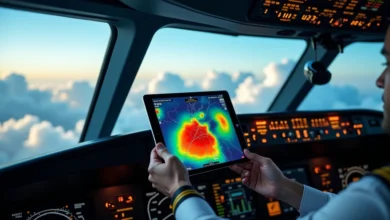
Breaking Down AI in Healthcare: From Patient Data to Life-Saving Decisions
The global market for healthcare AI will reach $102.7 billion by 2028. This AI revolution could save $150 billion annually by streamlining processes, reducing diagnostic errors and making treatments more effective. AI-powered tools now improve disease diagnosis by a lot, with accuracy rates jumping 20-30% and drug development time cut in half.
AI has reshaped the medical field through individual-specific medicine that adapts treatment plans to each patient’s specific traits. AI “scribes” have boosted patient interaction time by 20% while reducing physicians’ after-hours workload by 30%. Advanced algorithms now analyze X-rays, MRIs, and CT scans with exceptional accuracy. Healthcare access remains unavailable to 4.5 billion people worldwide, but AI and machine learning could help close this crucial gap.
AI-Powered Diagnostics: From Imaging to Early Detection
Image Source: LinkedIn
“All the applications in our portfolio will ultimately have an AI model. It’s inevitable. Predictive models can help inform physicians and reduce their cognitive burden, which is transformative for wellness and quality of care. There are also a lot of opportunities for real savings in the revenue cycle when AI models are applied in the right place. All boats will rise with AI.” — Gary Fritz, Vice President and Chief of Applications, Stanford Health Care
AI implementation has transformed medical imaging interpretation remarkably. AI-based diagnostic tools speed up complex image analysis and improve early disease detection that leads to better patient outcomes. Healthcare professionals now have a new way to identify and treat conditions earlier than ever before.
AI in Radiology: CT, MRI, and X-ray Analysis
AI algorithms excel at extracting useful information from radiological images. These systems analyze medical images faster and more precisely through sophisticated machine learning techniques. They can spot early-stage diseases that doctors might miss using traditional methods. To name just one example, combining low-dose computed tomography with AI has reduced lung cancer deaths by 20-43%.
AI-enhanced MRI works great for diagnosing liver cancer and other conditions with unique imaging patterns. AI improvements in chest X-rays detect more lung cancers than standard analysis methods. These tools work well across organ systems. AI models continue to show promising results as they detect abnormalities, identify specific structures, and predict disease outcomes.
Early Cancer Detection with Deep Learning Models
Deep learning models detect cancer with amazing accuracy across many specialties. AI algorithms identify potential lung tumors with 94% accuracy, performing better than professional radiologists. Machine learning programs achieve accuracy scores of 0.98 for colon cancer, which beats the average pathologist score of 0.969.
Here are some notable achievements:
- DenseNet121 reached 99.94% validation accuracy for detecting cancer in brain, oral, breast, kidney, leukemia, lung, colon, and cervical regions
- AI-powered mammography matches or exceeds clinicians’ accuracy in breast cancer detection
- Enhanced CNN models achieved a perfect 100% testing accuracy for lung cancer classification
Natural Language Processing in Clinical Notes
NLP provides excellent solutions for extracting key information from clinical notes, especially since 80% of medical data exists in unstructured format. These AI systems read medical documents and understand both the words and their context.
NLP tools have successfully pulled information about medications, symptoms, smoking history, and cancer staging from 2 million clinical notes. This technology helps especially when dealing with chronic diseases where clinical notes often contain more details than structured data. Recent research shows NLP models can extract cardiac functional status from clinical documentation with class-weighted AUROCs of 0.98-0.99.
Differential Diagnosis Support Systems
AI-powered differential diagnosis systems have transformed clinical decision support. These tools analyze patient symptoms, diseases, and organ systems to suggest possible diagnoses accurately. AI-enhanced differential diagnosis tools can cut diagnostic errors by up to 30% in challenging clinical cases.
AMIE stands out as an AI system that excels at clinical diagnostic reasoning. It creates high-quality differential diagnosis lists that contain correct diagnoses. AMIE helped doctors improve their diagnostic skills when tested on challenging case reports from the New England Journal of Medicine. These systems boost patient safety, increase doctor’s productivity by 25%, and save money by reducing unnecessary tests.
Personalized Treatment Planning Using Patient Data
Image Source: Brainvire
AI systems now play a significant role in adapting treatment plans to each patient’s unique biological and clinical characteristics. Personalized medicine uses specific medical data to develop strategies that recognize and treat illnesses based on individual health profiles. This approach shifts healthcare from generic treatments to individual-specific interventions that work best while reducing side effects.
Genomic Data Analysis for Precision Medicine
Blood type discovery and its effect on transfusion safety marks the earliest example of personalized medicine from the early twentieth century. AI algorithms now analyze genetic data at unprecedented speed and scale to find patterns humans cannot detect manually. High-throughput next-generation sequencing technologies, like Illumina’s MiSeqDx (FDA approved in 2013), have reshaped the scene by enabling many genome-based tests.
Managing genomic data faces major challenges due to:
- Data volume from high-throughput technologies
- Need for specialized genomic data analysts and powerful computing resources
- Demand for sophisticated databases, algorithms, and software programs
Compression algorithms and reference genome comparison techniques can reduce stored genomic data size to deal with these challenges. Specialized information systems like openBIS (open-source Biology Information System) have been created to manage large-scale biological data.
AI-Driven Chemotherapy and Drug Response Prediction
AI algorithms excel at predicting how patients respond to specific treatments by analyzing genetic profiles, tumor characteristics, and past treatment outcomes. Researchers created a machine learning algorithm for triple-negative breast cancer (TNBC) treatment that predicts chemotherapy response before the first infusion. The system correctly identified 42 of 51 positive responders and 29 of 34 non-responders.
AI prediction models’ success depends on:
- Data quality and diversity
- Feature selection methods
- Algorithm selection suited to the prediction task
Drug response prediction through machine learning has grown from basic linear regression models to advanced approaches. MammaPrint (a 70-gene signature) and Oncotype DX (a 21-gene signature) led this field for breast cancer treatment planning. Advanced algorithms like random forests and gradient boosting machines showed better results—reaching accuracy scores up to 0.75 compared to 0.55 for logistic regression in predicting insulin treatment responses.
Clinical Decision Support Systems (CDSS)
Clinical Decision Support Systems are vital applications of AI in personalized treatment planning. These systems analyze patient data including clinical records, lab results, and up-to-the-minute monitoring information to give healthcare professionals evidence-based recommendations during care.
AI has changed CDSS through three key technologies:
- Machine learning algorithms that analyze patient data and make predictions
- Natural language processing that extracts insights from clinical text
- Deep learning models that find complex patterns from diverse medical data
Komorowski et al. developed an AI clinician system that uses reinforcement learning to adjust sepsis treatment regimens based on patient responses. Doctor AI system uses recurrent neural networks to detect heart failure early, enabling preventive interventions.
AI integration in CDSS has improved healthcare delivery by increasing diagnostic accuracy, optimizing treatment plans, and boosting physician efficiency by 25%. Notwithstanding that, challenges in interpretability, bias mitigation, and ethical considerations need solutions to realize AI-powered personalized treatment planning’s full potential.
Remote Monitoring and Predictive Analytics in Patient Care
Image Source: OSP Labs
Patient health monitoring outside hospitals has become a crucial advancement in healthcare. AI helps healthcare providers track patients from afar, predict health issues, and take preventive action. This approach has transformed traditional reactive care into a more proactive model.
Wearable Devices and Real-Time Health Tracking
AI combined with wearable technology creates powerful health monitoring tools. Modern wearables track several body measurements, including:
- Heart rate, blood pressure, and oxygen saturation
- Sleep patterns and physical activity levels
- Stress indicators and breathing patterns
AI-powered devices analyze body signals with high precision. The SGD model in vital sign monitoring systems achieves up to 97% accuracy in health state classification. Healthcare professionals can spot early warning signs and act quickly by collecting and analyzing data live. The switch from occasional check-ups to ongoing monitoring has changed how healthcare works.
Predicting Hospital Readmissions with AI Models
Hospital readmissions cost Medicare about $99.14 billion each year. AI has become a key tool to solve this problem. Advanced machine learning models study electronic health records and predict readmission risks with remarkable accuracy—reaching AUC scores of 0.83. This shows major progress compared to traditional methods like the LACE model (AUC 0.66).
Wearable sensor data makes these predictions even better. Heart rate patterns measured through multiscale entropy help doctors tell which patients might need readmission. Healthcare systems can focus their resources on high-risk patients by using AI-driven prevention strategies.
Chronic Disease Management via Smart Devices
AI-powered remote monitoring systems help patients with chronic conditions. These systems analyze data from various sensors and health records to provide complete care oversight. They work well for managing heart disease, diabetes, and breathing problems by tracking specific health indicators.
Healthcare providers can adjust medications, suggest lifestyle changes, or increase monitoring without seeing patients in person. These technologies help reduce healthcare gaps between cities and rural areas. Patients in remote locations can now connect with urban medical specialists through telemedicine platforms.
AI in Drug Discovery and Clinical Trials
Image Source: Petrie-Flom Center
Traditional drug development takes 10-15 years and costs between $1.5-2 billion. AI is changing this digital world by speeding up discovery and cutting costs throughout the pharmaceutical pipeline.
Compound Screening and Drug Repurposing
Drug repurposing helps find new uses for existing medications. AI has revolutionized this approach. AI systems analyze massive biomedical datasets to identify existing drugs that could treat different diseases, which shortens development cycles. Baritinib serves as a prime example. Scientists originally developed it for rheumatoid arthritis. AI-generated knowledge graphs later showed it could inhibit AAK1, a key factor in SARS-CoV-2 infection. Machine learning has helped scientists repurpose many medications by analyzing chemical structures:
- Thalidomide (from morning sickness treatment to multiple myeloma therapy)
- Sildenafil (from cardiovascular medicine to erectile dysfunction treatment)
- Minoxidil (from antihypertensive to hair loss treatment)
AI in Clinical Trial Participant Selection
Finding the right clinical trial participants takes time but remains vital for research success. The NIH’s TrialGPT algorithm matches volunteers to relevant trials on ClinicalTrials.gov as accurately as human clinicians. Clinicians who use TrialGPT spend 40% less time screening patients while maintaining similar accuracy levels.
AI also streamlines trial design through predictive analytics. These systems look at historical data to predict outcomes, which helps researchers make better decisions about drug dosage and spot side effects early. AI algorithms paired with wearable technology offer immediate insights during studies and improve medication adherence through digital biomarkers.
Generative AI for Molecule Design
Scientists estimate the theoretical chemical space contains about 10^60 possible compounds. This makes traditional discovery methods impractical. Generative AI guides researchers through this massive molecular universe using inverse design to create molecules with specific properties. Advanced techniques like variational autoencoders, neural networks, and diffusion models let scientists explore unprecedented possibilities.
The X-LoRA-Gemma model uses 7 billion parameters and rearranges its structure through dual-pass inference to solve problems in various scientific fields. REINVENT and other generative models tackle inverse design challenges through reinforcement learning. These models work more efficiently than other methods.
Virtual Health Assistants and Administrative Automation
Image Source: Alamy
“Our private cloud has the same tools and capabilities as most hyperscalers. We’re able to spin environments up and down. We have consolidated tech stacks and automated functions. Since completing our data center consolidation in 2022, we’ve seen a $2 million annual cost reduction and decreased the number of priority 1/severity 1 incidents by 50%. Today, we’re 40% in the cloud. I firmly believe by 2030, 90% of our environment will be in the cloud.” — Christian Lindmark, Vice President and Chief Technology Officer, Stanford Health Care
Healthcare spending wastes almost 20% on paperwork that could help patients directly. AI technology now revolutionizes these processes with virtual assistants and automation tools that boost efficiency and make healthcare more accessible.
24/7 AI Chatbots for Symptom Checking
AI-powered chatbot symptom checkers (CSC) help people understand their health issues and guide them about next steps. These virtual assistants have become extremely popular, with some apps reaching over a million downloads from app stores. The numbers show their usefulness—76.3% of users rely on these tools to understand their symptoms better, while 33.2% use them to decide if they need medical help. The satisfaction rate stands impressively high at 91.4% among users.
Automated Medical Coding and Billing
AI systems revolutionize revenue management by decoding medical terms in patient records and assigning proper codes within seconds. These systems maintain 95% accuracy and provide clear audit trails for each code. Healthcare facilities that use automated coding have cut their costs by 27%. Medical coding costs the most in revenue cycle management, so these improvements let organizations spend more on patient care.
AI Scribes for Live Documentation
AI scribes record doctor-patient conversations and create medical notes automatically, which lets doctors focus on their patients instead of typing. A 63-week study with over 2.5 million patient visits showed that AI scribes saved doctors 15,791 hours of paperwork—equal to 1,794 eight-hour workdays. Patients saw real benefits, as 47% said their doctors spent less time on computers during visits. The doctors benefited too—84% reported better patient communication, and 82% felt more satisfied at work.
Appointment Scheduling Optimization
Smart scheduling systems examine past patient data, doctor availability, and resource usage to create the best possible schedules. These systems handle no-shows by using machine learning to predict which patients might miss appointments and adjust booking accordingly. Better scheduling not only improves efficiency but also makes patients happier with their care.
AI keeps transforming healthcare in many ways. Medical professionals now diagnose diseases with amazing accuracy and provide treatments tailored to each patient’s needs. Health tracking outside clinics has become possible through remote monitoring technologies. This has changed healthcare from treating sick people to preventing illness in the first place.
The effects spread throughout the pharmaceutical industry. AI-powered compound screening and molecule design have sped up drug discovery processes that used to take decades. Better participant selection and real-time data analysis have helped clinical trials. This ended up making life-saving medications available faster.
Maybe just as important, automated systems for documentation, coding, and scheduling have reduced administrative work in healthcare. Doctors now spend more time with patients instead of doing paperwork. This has improved both care quality and job satisfaction.
These advances are remarkable, but challenges still exist. We need to address patient privacy, algorithm bias, and fair access as AI healthcare technologies grow. Human expertise and compassion must stay at the center while technology serves as a tool rather than replacing the human touch in medicine.
The path ahead looks clear. AI will help more people get quality care while making treatments more effective and affordable. Technology alone can’t fix everything in healthcare, but it’s without doubt a driving force for positive change in medicine. Healthcare’s future lies where human expertise meets artificial intelligence—a partnership that will help patients worldwide get better care.






